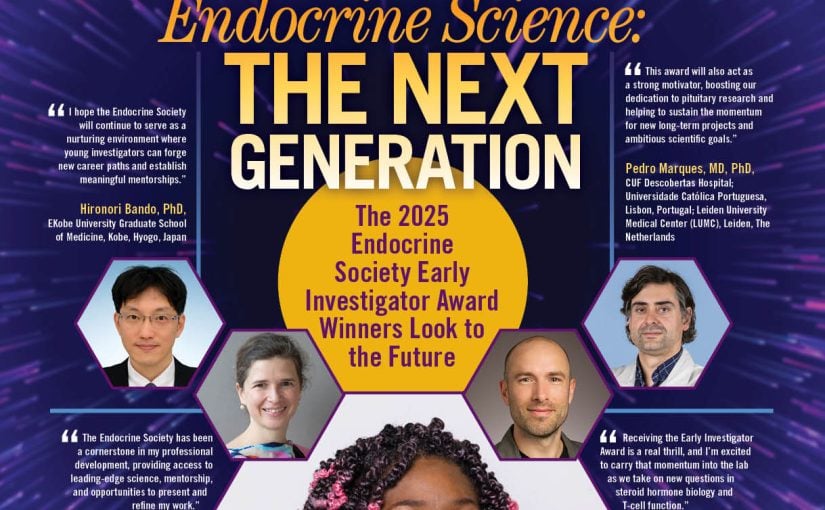Monica M. Laronda, PhD, and Jane E. Reusch, MD, have long been leading advocates for the importance of equity in scientific research, specifically as it relates to women’s health. As they engage with national initiatives focusing on how this research is funded, they spoke to Endocrine News to discuss the latest in these efforts, their own research, and potential opportunities for future funding for studying women’s health.
Last November, President Joe Biden and First Lady Jill Biden, EdD, launched the White House Initiative on Women’s Health Research to “to fundamentally change how our country approaches and funds research on women’s health.” A few months later, in January 2024, a National Academies of Sciences, Engineering, and Medicine (NASEM) committee held a public workshop with the task of developing recommendations regarding the structure of the National Institutes of Health (NIH) and to ensure optimal funding for women’s health. NASEM also announced it was convening an ad hoc committee to address the wide and persistent gaps in women’s health research across all of the NIH.
These efforts are long overdue. Women, of course, make up half the population, but most research is focused on men’s bodies – often those data and results wouldn’t apply to women. “Research on women’s health is drastically underfunded, leading to significant research gaps, with serious consequences for the health of women across the country,” the White House said in a statement. “This lack of investment limits our understanding of conditions that are specific to women, predominantly affect women, or affect women differently.”
Meanwhile, the NASEM committee will make recommendations to the NIH on funding priorities, education, and training programs to build and support a “robust women’s health research workforce,” review processes, and allocation of funding to address gaps in women’s research.
Because hormones are one major contributor to what makes men and women develop disease – and respond to treatment – differently, the Endocrine Society has responded to both of these efforts, giving its own recommendations to the White House and NASEM, while a couple of members were given the opportunity to take a more personal and intimate approach to be involved with these initiatives.
In March, Monica M. Laronda, PhD, an investigator at Ann & Robert H. Lurie Children’s Hospital of Chicago and assistant professor of Pediatrics and Obstetrics and Gynecology at Northwestern University Feinberg School of Medicine, representing the Society’s Research Affairs Core Committee, shared the Society’s perspective on women’s health research at the NASEM stakeholder meeting.
On April 20, Jill Biden visited the Ludeman Family Center for Women’s Health Research at the University of Colorado Anschutz Medical Campus, where she met Jane E. Reusch, MD, associate director of the Ludeman Center and professor of medicine in the Division of Endocrinology, Metabolism and Diabetes, where Reusch was able to explain the sex differences in diabetes.
Endocrine News caught up with Laronda and Reusch to discuss these efforts to address women’s health research, how their own work is shaping those efforts, and how endocrinology will play a role in narrowing – and hopefully – eliminating these gaps.
Endocrine News: Dr. Laronda, can you discuss your research, and why basic research on reproductive biology is a critical need for women’s health?
Monica M. Laronda: Our research aims to understand human gonadal biology to inform how we preserve and restore fertility and gonadal hormones in patients that will undergo gonadal insufficiency because of a treatment — as in cancer patients — or disease – as in differences in sex development/intersex patients. Our main focus has been on ovarian biology and engineering a bioprosthetic ovary to restore fertility and ovarian hormone function. We develop processing, anatomy and cell annotations standards for cryopreservation and collaborative analyses, engineer our own materials with specific physical and biochemical components, use omics and spatial technologies to map the human ovary across the lifespan, and use human induced pluripotent stem cells and human tissue to translate this research into clinical practice.
While we study organs that are important for reproduction, it is important to think of the effects of ovarian or testicular hormones on all organs and across the lifespan.
EN: Dr. Reusch, tell us about your research, and why it’s so important to better understand sex differences in diabetes.
Jane E. Reusch: The NIH and VA sponsored research that I do with my lab in collaboration with Drs Judy Regensteiner and Kristen Naduea is focused on understanding the molecular underpinnings of diabetes related decline in cardiorespiratory fitness in adults and youth with type 1 and type 2 diabetes. Decreased cardiorespiratory fitness is the #1 predictor (stronger than LDL cholesterol) of premature morbidity and mortality. In our lab, but not all labs, this defect in cardiorespiratory fitness is worse in girls and in women. In addition, girls and women are less physically active thereby compounding the physiological impairment and negative health consequences. We have employed youth, adults and preclinical animal models to gain understanding into the defect and to define strategies to restore fitness. We have learned that prior to any classic microvascular or macrovascular complications of diabetes there is a change in the function of the heart and the skeletal muscle related to insulin resistance and changes in perfusion. We are using animal models and interventions in people with diabetes (including exercise training and pharmacological intervention) to restore function and improve cardiorespiratory fitness. Responses to these interventions are specifically different in female animal models and our research is Working to discern sex differences in people with diabetes.
Very important for the field of Women’s Health research is the epidemiological observation that when a woman develops diabetes prior to menopause, she loses the gender-related delay in cardiovascular event that is usually present in women prior to menopause. Loss of this female specific delay in cardioprotection, enhances the deleterious effects of diabetes in women. In addition, women with diabetes have worse outcomes when they suffer a cardiovascular event, such as a myocardial infarction, and they are less likely to be treated with the interventions that are evidence based and routinely afforded to men. Finally and tragically, 2/3 of type 2 diabetes in youth presents in adolescent girls compared to boys. Younger onset diabetes accelerated cardiovascular and microvascular complications compared to adult onset (after the age of 40) type 2 diabetes. As such adolescent girls and young women are exposed to a lifetime of risk. Simply stated, it is important to study sex differences in diabetes.
EN: Dr. Laronda, can you tell us more about your experience sharing the Endocrine Society’s perspective with the National Academies Committee on the Assessment of NIH Research on Women’s Health and what the key messages were?
MML: Several key members of the RACC met to identify key areas that we wanted to emphasize. We chose to emphasize the importance of understanding sex as a biological variable, consideration for women’s health research across the lifespan, increasing diversity and inclusion across the biomedical research enterprise and encouraging researchers to study women’s health. It was a pleasure to represent the Society at this meeting and listen in on other testimonies from physicians, scientists, and patients. While there was a clear consensus with the White House’s statement, each individual or group there had a unique emphasis, and it was important that our perspective was noted.

“Women’s health research has often been pigeon-holed by narrowing women’s health to primarily include reproductive organs during the reproductive lifespan. An endocrinology perspective is critical as gonadal hormones are vital before and after reproductive age and for biological processes beyond reproduction.” — Monica M. Laronda, PhD, investigator, Lurie Children’s Hospital of Chicago; assistant professor of pediatrics and obstetrics and gynecology, Northwestern University Feinberg School of Medicine, Chicago, Illinois
EN: Dr. Reusch, what were some of the important issues you shared with Dr. Jill Biden during her visit to your institution to discuss the White House Initiative on Women’s Health Research and what do you hope the Initiative will achieve?
JER: Our visit was specifically focused on cardiovascular disease in women and highlighting the need to understand similarities and differences in disease pathogenesis and response to therapeutics in women and men/girls and boys.
A point of discussion was that we need sophisticated study design and methodology to disentangle the effects of sex and gender on disease development and outcomes. We need to prepare study sections and manuscript reviewers to fairly address sex differences and sex as a biological variable (SABV) — research such that it is field changing and truly informative. We need to normalize the expectation that basic and clinical investigation as well as randomized clinical trials will include thoughtful study design to address sex/gender differences and SABV.
Finally, we discussed the need to leverage the evolution of large datasets to begin to understand the interaction of sex and gender on outcomes, treatments and health. Incorporating gender into big-data, real world analyses is only possible in as much as these data are collected. As such one priority is the need to create EHR and large clinical data set infrastructure that is refined to include parameters that capture the impact of gender on health. First the factors need to be carefully identified and thoughtfully built into RCTs and epidemiological data sets.
EN: Can you share why it’s important for the field of endocrinology to have a voice in future direction for women’s health research?
JER: It is critical for endocrinology to lead the field of sex differences and SABV, as we are known as the “hormone doctors”. Whether true or not, sex differences are often attributed solely to hormones. To that end, endocrinology needs to provide expertise on how to evaluate the contributions of sex hormones, genetic sex, gender, and other factors into the study of women’s health research.
The field of endocrinology has defined the impact of sex and sex hormones from prior to conception through aging. We need to support the field to effectively move observations and small studies into the mainstream for our understanding of sex differences across the lifespan.

“Women with diabetes have worse outcomes when they suffer a cardiovascular event, such as a myocardial infarction, and they are less likely to be treated with the interventions that are evidence based and routinely afforded to men. So, it is important to study sex differences in diabetes.” — Jane E. Reusch, MD, associate director, Ludeman Center; professor of medicine, Division of Endocrinology, Metabolism and Diabetes, University of Colorado Anschutz Medical Campus, Aurora, Colorado
MML: Those who study hormones understand their systemic impact on one’s health and are forced to think holistically. Those who are not cisgender men have been historically overlooked as more complicated or challenging to study, which has resulted in women developing adverse effects to medications or taking medications with an unknown risk.
Women’s health research has often been pigeon-holed by narrowing women’s health to primarily include reproductive organs during the reproductive lifespan. An endocrinology perspective is critical as gonadal hormones are vital before and after reproductive age and for biological processes beyond reproduction. Additionally, hormones from other organ systems may be made, released or affect tissues differently depending on the chromosomal sex or gonadal hormone milieu of the individual. Endocrinology provides an important perspective to identify and address these gaps. We must continue to use our voice to address these gaps in knowledge.
EN: What are some critical research opportunities that funding agencies should consider as they develop plans and priorities to advance women’s health?
MML: Inclusive and expansive women’s health research should be encouraged across all NIH institutes and centers. There should be incentives to considering sex as a biological variable and for considering women’s health across the life course. Clinical targets and goals that are inclusive and precise in this way should be prioritized. Replication studies may be necessary in some fields to ensure a more rigorous sex-specific analysis and improve outcomes for historically marginalized groups, including women.
JER: : I will mention a few crucial research priorities in my area of work. Research needs to carefully interrogate the parameters that change with menopause that permit accelerated cardiovascular disease progression; define the maladaptive response to diabetes that negates cardioprotection in the pre- and perimenopause; understand why girls develop diabetes in youth more commonly than boys; develop sophisticated methodology for genetics, metabolomics, transcriptomics and epigenomics to assess data based upon the impact of genetic sex and sex hormones; and most importantly, to consistently include women in randomized controlled trials with a pre-specified analysis plan to address sex differences and incorporate gender related parameters.
Bagley is the senior editor of Endocrine News. He wrote about some of the highlights from ENDO 2024 in the August issue.

